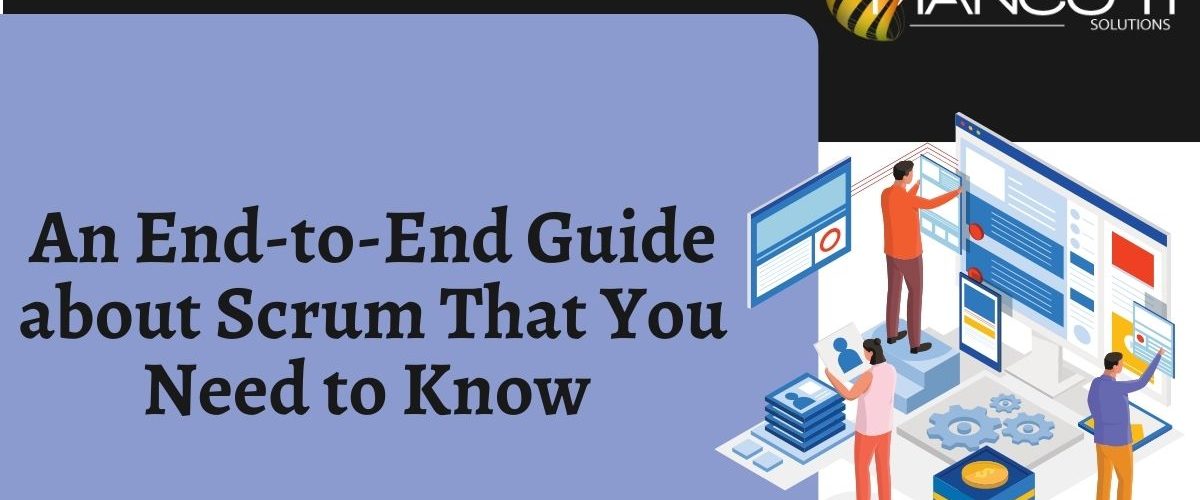
An End-to-End Guide about Scrum That You Need to Know
Scrum is a phrase used frequently in the web development community. In this post, we will look at what it is and its many characteristics. Consider a framework that is utilized in software development, sales, marketing, sophisticated technologies, and, increasingly, in just about every company on the planet. A framework that can assist teams in achieving the organization’s goals by allowing them to work toward goals that are broken into iterations.

What exactly is Scrum?
Scrum is a framework for facilitating teamwork. Scrum development encourages teams to learn via experiences, self-organize while working on a problem, and reflect on their victories and losses to continuously improve, much like a rugby team (from which it gets its name). It’s sometimes referred to as an agile project management framework.
Scrum Development – The Framework
The Scrum system is the name for a collaborative development approach that provides a good set of principles to aid programming designers in their project development. This ensures that you don’t run into any problems throughout the development process of your product.
The conventional consensus is that you provide partners with standard updates and criticism (individuals keen on how your undertaking is going). They can also offer criticism and suggestions to keep things on track. The Scrum cycle involves breaking the project down into small steps and having everyone provide valuable feedback on what works and what doesn’t. By checking in with partners on a regular basis, organizations can adjust and refresh their arrangements as needed before moving on to the next level.
A Scrum Development Team is made up of people who work together to solve problems.
Scrum is built around a small group of people called a Scrum Team. One Scrum Master, one Product Owner, and the developers make up the Scrum Team. It is a group of professionals who work together to achieve one goal at a time, the Product Goal.
Scrum Teams are cross-functional, which means that each member possesses all of the abilities required to provide value in each Sprint. They’re also self-managing, which means they pick who does what, when, and how on their own.
The Scrum Team is typically 10 or fewer people, small enough to remain nimble yet large enough to perform considerable work during a Sprint. We’ve discovered that smaller teams communicate better and are more productive in general. If Scrum Teams get too large, they should consider splitting up into several coherent Scrum Teams, each focusing on the same product. As a result, the Product Goal, Product Backlog, and Product Owner should all be the same.
There are three key roles in the Scrum team.
Owner of the Product:
A product owner is responsible for determining the business worth of a customer’s or client’s wants.
By determining product features, laying them out, ranking them, prioritizing what needs to be focused on for forthcoming sprints, prioritizing it, and making refinements, the product owner must be able to maximize ROI.
The product owner manages the project backlog and makes the necessary decisions to complete the project.
Scrum Master (Scrum Master):
The Scrum master assists teams in learning and applying Scrum concepts in order to achieve business value.
The Scrum Master ensures that the team is held accountable for attaining the organization’s business goals and removes roadblocks that could slow down the team’s progress.
They’re also in charge of planning important Scrum events and meetings.
Artifacts from the scrum
Let’s begin by identifying the three scrum artifacts. Artifacts are something we create, such as a tool for solving a problem. A product backlog, a sprint backlog, and an increment with your definition of “done” are the three artifacts in the scrum. They are the three constants in a scrum team, which we revisit and invest in on a regular basis.
Product Backlog
The product owner or product manager maintains the product backlog, which is the principal list of work that has to be completed. This is a live list of features, requirements, upgrades, and fixes that the sprint backlog uses as input. It’s the team’s “to-do” list. The Product Owner regularly re-prioritizes and maintains the product backlog because when we learn more or the market evolves, products may no longer be relevant or problems may be solved in different ways.
Sprint Backlog
Sprint Backlog is a set of user stories or bug fixes picked for the current sprint cycle. The team decides which items from the product backlog to work on for the sprint in the sprint planning meeting. A sprint backlog might be flexible and change throughout the sprint. The primary sprint goal — what the team intends to accomplish in this sprint – cannot, however, be compromised.
Increment
The usable end-product of a sprint is the increment (or Sprint Goal). Normally “increment” is exhibited during the end-of-sprint demo, where the team shows what was accomplished throughout the sprint. You might not hear the phrase “increment” in everyday conversation because it’s commonly referred to as the team’s definition of “Done,” a milestone, a sprinting target, or even a full version or a deployed epic. It simply depends on how your team defines “Done” and how your sprint goals are defined.
Conclusion
The scrum development structure is straightforward. The game’s rules, objects, events, and roles are all simple to comprehend. Its semi-prescriptive approach really aids in the removal of ambiguity in the development process while allowing enterprises to add their own unique flavor.





